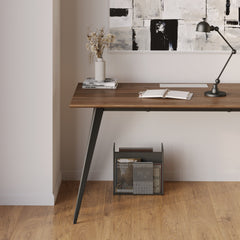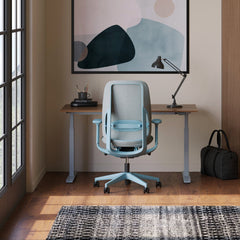Get 10% off your first order
Find the office furniture that’s designed to match your style, comfort, and needs perfectly. Subscribe
Spaces That Shift With You: Building a Workspace That Adapts to Every Task

Visit quiz page to see how we makes it easy to create an inspiring workplace

 Working from home isn’t just a change of location—it’s a shift in how we experience work. With long hours spent seated, often in improvised setups, many people overlook one essential factor: ergonomics. The design of your table influences posture, energy, and focus more than you might realize.
Working from home isn’t just a change of location—it’s a shift in how we experience work. With long hours spent seated, often in improvised setups, many people overlook one essential factor: ergonomics. The design of your table influences posture, energy, and focus more than you might realize.
An ergonomic table isn’t just furniture—it’s a tool for performance and well-being. Let’s explore how the right setup supports better habits, health, and productivity for remote workers.
Ergonomics is about designing environments that fit the human body. For remote workers, it’s the key to maintaining comfort and energy throughout the day.
Keep posture aligned with natural movement.
Reduce unnecessary strain or reaching.
Adjust furniture to your body’s proportions.
Create a layout that supports transitions and breaks.
A workspace designed for you—not against you—builds long-term health and focus.
Home offices are often created from spare corners or kitchen tables, but convenience doesn’t always mean comfort. Without proper design, you risk fatigue, poor posture, and loss of focus.
A flexible option like the Small Standing Desk Wisconsin allows you to adapt your position naturally, promoting circulation and comfort throughout the day.
|
Habit |
Result |
Fix |
|
Hunching over laptop |
Back pain |
Raise monitor height |
|
Sitting for hours |
Stiffness |
Alternate positions |
|
No wrist support |
Strain |
Use padded surface |
|
Poor lighting |
Fatigue |
Adjust brightness |
An ergonomic setup helps you move and think with less effort.
Ergonomic furniture supports more than posture. It encourages movement, reduces strain, and improves circulation—all essential for those working long hours from home.
Improves spinal alignment.
Reduces tension in shoulders and neck.
Enhances focus through balanced positioning.
Prevents repetitive stress injuries.
Ergonomic design is the foundation of sustainable work habits.
Comfort directly affects how efficiently you work. A well-designed table helps you stay present and motivated without the constant need to readjust or stretch uncomfortably.
A standing desk gives flexibility that keeps your body active while your mind stays sharp.
Reduces fatigue during long work hours.
Supports active focus by allowing motion.
Creates balance between energy and rest.
Makes transitions between tasks smoother.
When your setup feels effortless, your work naturally follows suit.
According to a research article on ergonomic office design, posture-friendly setups not only reduce physical pain but also enhance cognitive performance. Workers with adjustable furniture experience better focus and longer concentration spans.
Ergonomic improvements lower stress by 32%.
Movement-friendly desks increase alertness.
Proper desk height boosts mental clarity.
Workers in ergonomic setups report higher satisfaction levels.
Science confirms that design directly impacts focus and creativity.
You don’t need an entire renovation to improve ergonomics. A few small adjustments can completely change how you feel during work.
|
Element |
Goal |
Adjustment |
|
Desk height |
Align elbows at 90° |
Use adjustable furniture |
|
Chair support |
Maintain posture |
Add lumbar cushion |
|
Monitor position |
Eye level |
Use riser or stand |
|
Foot placement |
Grounded balance |
Add small footrest |
Ergonomics starts with awareness and consistency, not perfection.

Your desk defines your workspace. The best designs adapt to you, not the other way around. A versatile office desk combines style and ergonomics, helping you stay productive without sacrificing comfort.
Adjustable height and ample surface space.
Rounded edges for comfort.
Sturdy build to prevent wobble.
Clean, minimal design to reduce distraction.
A supportive desk makes the difference between daily fatigue and lasting focus.
Ergonomic setups aren’t limited to large home offices. Compact spaces can still be optimized for movement and comfort.
Choose foldable or adjustable desks.
Keep cables managed for a clear workspace.
Mount lighting and shelves vertically.
Use multifunctional furniture that adapts to your tasks.
Small changes lead to big improvements in how you work.
If you share your workspace, design should support flexibility for everyone. A quad workstation layout provides balance between privacy and collaboration.
Maintain adjustable zones for individual comfort.
Use neutral lighting to reduce glare.
Ensure enough legroom between sections.
Keep shared tools accessible but organized.
Ergonomic design brings harmony to shared work experiences.
Comfort isn’t only physical—it’s mental. A space that feels balanced encourages calm and motivation. The arrangement of your table, chair, and accessories can subtly influence your daily mindset.
Use natural tones to ease stress.
Maintain symmetry for visual stability.
Keep clutter minimal to support focus.
Personalize with one meaningful object.
A calm workspace helps your thoughts flow naturally.
The next wave of remote work furniture blends technology with adaptability. Smart desks and responsive layouts adjust to your habits automatically, bringing ergonomics into the digital era.
|
Trend |
Focus |
Benefit |
|
Smart sensors |
Posture monitoring |
Prevents strain |
|
Modular setups |
Flexibility |
Fits any space |
|
Sustainable materials |
Eco-design |
Reduces impact |
|
Height automation |
Comfort |
Encourages movement |
Ergonomics is evolving to make remote work more intuitive and responsive.
True ergonomics isn’t a one-time setup—it’s a habit. Maintaining posture, refreshing layouts, and moving regularly ensure lasting comfort and performance.
Reassess posture weekly.
Adjust desk height seasonally.
Replace worn-out accessories.
Keep evolving your setup with needs.
Sustainability in comfort is the secret to enduring productivity.

Ergonomics bridges design and wellness. It’s not about perfection—it’s about awareness and intention. A well-designed workspace supports your best work and your best self.
Ergonomic tables build comfort through adaptability.
Design affects both physical and mental performance.
Movement and mindfulness go hand in hand.
Investing in good furniture is investing in your focus.
Your table is more than a surface—it’s the foundation of how you live and work each day. When comfort meets clarity, productivity becomes natural.

Spaces That Shift With You: Building a Workspace That Adapts to Every Task

Room to Think: Designing an Efficient Workspace Without Overcrowding

The Art of Flow: Simple Table Arrangements for a Balanced Home Office
Get 10% off your first order
Find the office furniture that’s designed to match your style, comfort, and needs perfectly. Subscribe
Leave a comment